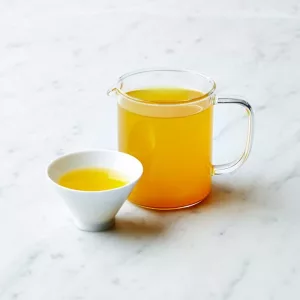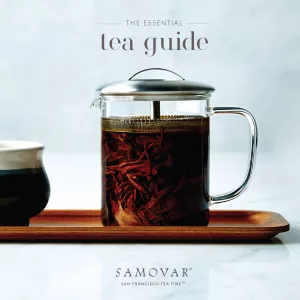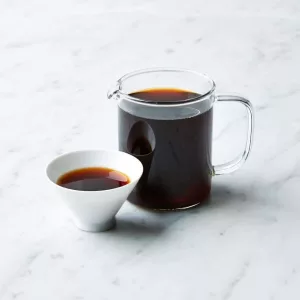By Jane Meredith Adams, Special to the Tribune
Published January 8, 2007
 SAN FRANCISCO — In a city saturated with coffeehouses, a state awash in lattes and a nation deeply in love with a cup of joe, they have come for tea. With their heads bent over stainless steel tins of leaves at the Lupicia Fresh Tea boutique here, they sniff chocolate mint black and inhale blueberry-raspberry green. They come for tea because of beneficial flavonoids, exotic flavors and the elegance of an Asian ceramic teapot. They are top-of-the-line tea drinkers, and in a Starbucks world, their numbers are increasing.
SAN FRANCISCO — In a city saturated with coffeehouses, a state awash in lattes and a nation deeply in love with a cup of joe, they have come for tea. With their heads bent over stainless steel tins of leaves at the Lupicia Fresh Tea boutique here, they sniff chocolate mint black and inhale blueberry-raspberry green. They come for tea because of beneficial flavonoids, exotic flavors and the elegance of an Asian ceramic teapot. They are top-of-the-line tea drinkers, and in a Starbucks world, their numbers are increasing.
A coffee man in the morning, accountant Roy Wong wants nothing but green tea in the afternoon, and when it comes to green tea, he wants nothing but the best. Hence his pilgrimage to the Japanese-owned Lupicia, which offers 200 varieties of black, green, oolong and white teas.
“I’ve read that green tea helps prevent Alzheimer’s and helps with digestion, so why not?” Wong said.
Tea in America once meant a bag of Lipton floating in a cup. Green tea was a fringe product and white tea unheard of. All of this has changed, including the shape of the lowly tea bag, as U.S. tea sales are expected to grow to $10 billion by 2010 from $6 billion in 2005, according to the World Tea Expo, a trade show.
Driven by reports that tea has less caffeine than coffee, is loaded with antioxidants and may even help prevent tooth decay and Alzheimer’s disease, Americans are guzzling ever-increasing quantities of chilled, bottled tea. Premium loose-leaf teas also are surging in popularity, packaged in bulk or in silken, oversized tea pouches, which enable the leaves to unfurl.
Nationally, the number of tea cafes has boomed to 2,000 from 200 in the past decade, according to the Tea Association of the USA. California has the most, with the coffee-loving Midwest trailing. “The Midwest has always been a laggard when it comes to tea consumption,” said Joe Simrany, president of the Tea Association of the USA.
The TeaGuide, which maintains a list of tearooms worldwide in conjunction with the Cat-Tea Corner Web site, catteacorner.com, reports that there are 33 tea cafes in Chicago and 18 in the suburbs.
What’s in your tea bag
Just as wine, coffee and chocolate transformed from foodstuffs into gourmet pursuits, tea drinking has become a province of connoisseurs. Education is at the core of the transformation. The idea is that once
you’ve tasted high-end single-estate-grown Assam black tea, that cup of Tetley won’t be as appealing.
Take this bit of education from Kalvin Louis, co-owner of the Samovar Tea Lounge, a San Francisco Asian-themed food and tea salon. Traditional tea bags, Louis said, contain nothing more than discarded tea leftovers known as fannings, dust, soot or shake. As tea is processed, whole leaves are shaken in a mesh basket. What falls through is bagged.
“They color it and flavor it,” said Louis disdainfully as he sipped a cup of Ancient Tree hand-picked green tea.
The tea experience comes in two forms. In sync with the pace of American culture are bottled chilled teas, tea smoothies, sparkling tea mixed with fruit juice and bubble tea drinks–a Taiwanese specialty characterized by pearls of gummy tapioca at the bottom of the cup that are sucked up through a wide straw.
On the hot side, loose-leaf sellers such as L’Amyx Tea Bar in Oakland are selling the idea that pausing to steep a pot of tea is a calming respite from a hectic world. To this end, L’Amyx doesn’t sell take-out cups of tea.
But do Americans want to slow down?
“It’s an uphill battle with American culture,” said Marcia Lam, chief financial officer at L’Amyx, as she stood behind the bar, pouring tea made from delicate white buds. Just as yoga and spas have emerged as a way to find balance, so too has tea, she said.
Making the switch
In Chicago, even the pressure of law school can’t make Chrystina Zelaskiewicz, 26, drink a cup of coffee. On winter nights, she favors Fruit Blast herbal tea at Argo Tea on Rush Street.
“It’s hot, it tastes good and it doesn’t have caffeine,” she said. Herbal teas aren’t technically teas because they aren’t from the Camellia plant that is the source of all teas, but they’re steeped like tea and also are growing in popularity.
“I like the flavored teas,” said Chicago medical school student Bonnie Hoel, 25, who recently sipped a cup of Ginger Peach black at Argo Tea. When she’s at home, she’s partial to the milky cinnamon sweetness of chai black, which she pairs with homemade banana chocolate chip bread. She’s also acquired a taste for green tea. “It’s a little bitter, but I’ve heard about the health benefits of it,” she said.
Behind most tea drinkers is a conversion experience–the day they put down their java and picked up some oolong.
“I just realized how much better I felt when I drank tea,” said Dominic Martello, 55, a waiter who once drank four or five cups of coffee a day. “It’s easier on the stomach,” he said, sipping Jasmine Pearl green tea. Just as relaxing as drinking tea: the slow-paced tea house ambiance, he said.
“It’s a place to think about what I want to think about.”
Media Contact:
Jesse Cutler, Samovar: (415) 655-3431 / publicity@jpcutlermedia.com





